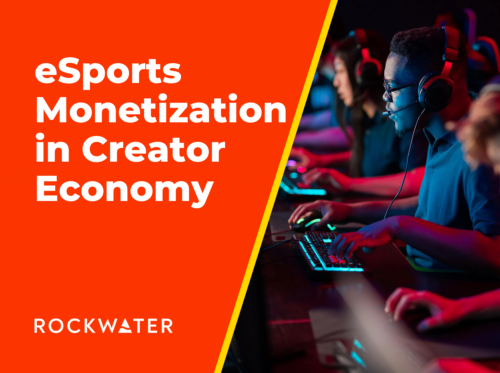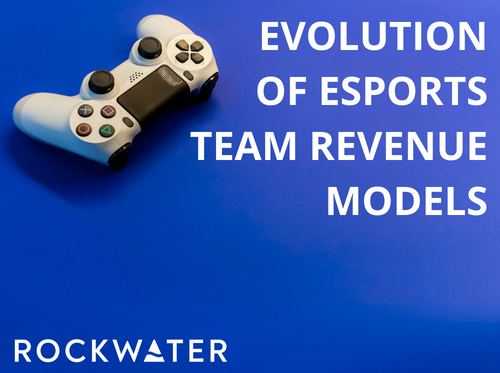eSports Revenue Potential in Creator Economy and Web3 (Pt. 3)
Part 3: eSports Revenue Opportunities in Web3 and the Creator Economy
The Creator Economy
eSports are in a unique position where they are largely intertwined with the creator economy. This started because video games have been a long-popular genre of online videos and live streaming, which allowed popular players (often professional players) to simultaneously become content creators. As live streaming platforms like Twitch developed over the years, the association between eSports, video games, and the creator economy has only become stronger, and we have been seeing new movements and trends in the intersection between the three.
- Many eSports players stream on the side. That is, whenever they are not playing in professional tournaments or championships, they often stream their practice and/or casual games for their fans to watch on platforms like Twitch. Streaming footage can also be repurposed into VODs for additional content, which are then often edited and uploaded on YouTube and/or Twitch. Some players like xQc (former professional Overwatch player) and AdmiralBulldog (former professional Dota 2 player) have even found so much success in streaming that they have quit playing in the professional leagues altogether. Overall, professional players streaming on the side yields three large benefits. First, perhaps obviously, it provides supplementary income through subscription fees, donations, and tips. Second, it serves as a grassroots way of fan-base building. Regular viewers of online videos or livestreams of a particular game may easily run into content from professional players and follow them. Third, it increases support for the professional teams themselves. As each professional player gathers fans from their own content, these fans more easily move up the funnel to support the teams they play for, some of which become superfans for those teams.
- Popularity of amateur-level eSports. While it makes sense that the best of the best players garner large viewership, what is perhaps more interesting is that players on the other end of the skill spectrum (i.e. amateurs) are often also able to obtain the same, if not larger, viewership. Creators ranging from platform-dominating streamers like Pewdiepie, Dr. Disrespect, or Ludwig can easily pull 7-figure viewership numbers. On the other hand, smaller creators resembling micro-influencers get lower numbers but have much stickier, loyal, and consistent fans. Altogether, the presence of all of these creators essentially serves as free marketing for many eSports titles as amateur gameplay viewership is a great foot in the door for competitive eSports viewership. In fact, amateur-level creators are arguably better feet in the door than professional players as they are much more versatile in the games they play: fans tend to stick around for the creators’ personalities and commentary rather than their technical finesse in specific games.
- Creators as eSports commentators. Though this is not necessarily unique to eSports, this is a large factor in the merging of eSports and the creator economy. Streaming models like co-streaming and watch parties allow creators to cover eSports games and tournaments in real time, much like traditional sports channels like ESPN. I see these creators as community versions of traditional sports channel commentators. They might not have as much viewership, but because of the interactiveness of livestream platforms, their viewers are often more engaged. Pair these streaming models with the fact that many professional players are also streamers and you also get an interesting opportunity where professional players themselves are the commentators for games and tournaments, either those that happened in the past or happen in real time. Large eSports tournaments often also invite professional players and ex-professional players to commentate live games in real time as talent.
- eSports are featured in Creator Events. In March 2022, streamer QTCinderella created the first in the series of The Streamer Awards, which featured awards in 27 categories and several dozen nominees. Many of these categories surrounded video games around which there exists an avid competitive eSports scene, and unsurprisingly, some of the nominees and winners were professional eSports players, like mang0 and Hungrybox, who are active in the Super Smash Bros leagues, and Alexandra Botez and Hikaru Nakamura, who are professional chess players (chess is surprisingly popular within the eSports community). While The Streamer Awards is only one of the few examples of a large-scale and well-produced creator event, its integration of eSports games and players shows the acceptance of eSports in the creator space.
- Creator-founded eSports Teams are only a recent phenomenon, but an incredibly interesting one. One of the best-known is Moist Esports, founded by variety streamer and YouTuber MoistCr1TiKaL, which quickly became one of the most popular and recognizable teams in the professional Super Smash Bros scene. Popular YouTuber Mr. Beast is also planning to create a League of Legends team before the end of 2023 that will compete against legacy teams in major tournaments and world series. These represent new opportunities for non-professional-competitor creators to collaborate with professional players. For example, eSports teams could be seen as subunits of popular creators’ brands. From a creator’s perspective, these could become interesting new alternative revenue streams if monetized properly. From a professional player’s perspective, these represent more chances to join a professional team and (consequently) to receive investment, training, and media exposure.
Web3, Blockchain, NFT
With web3 and blockchain technologies revolutionizing so many industries, it’s hard to think that gaming will not be affected, even though gamers in general have an aversion towards NFTs and web3 projects.
Some areas I think could yield interesting web3 applications are:
-
- NFT event passes and memorabilia. Tickets to real and virtual events could be sold as NFTs bundled with additional benefits, and tickets that have been used/redeemed in rare events could be productized into NFTs and sold on secondary markets, much like used tickets for legendary concerts or sports games (think tickets to Michael Jordan’s last game, one of which sold for nearly $468,000 earlier this year).
- Democratization of game development. Imagine games where players can vote on upcoming updates and features, tightening the relationship between the game developer team and the community of players. While this could be done without web3 technology, such democratization embodies the spirit of web3 and could easily be added to upcoming web3 games.
- Team communities. Unlike traditional sports, you can play video games with virtually anyone in the world at any time. This includes professional players – in fact, on pro players’ streams, non-professional players are ubiquitously found as teammates and enemies. This trait in video games could potentially be monetized by opening up access to eSports teams’ onilne communities (think Discord, metaverses, etc.), which would allow communication and partying with pro players. While this could be done without using any web3/blockchain technologies, potential implementations could feature systems resembling creator currencies (think rally.io, etc.) and their web3 communities.
- NFTs as virtual items. Skins, hats, cosmetics, and profile pictures could be implemented as NFTs and stored on the blockchain. This would only be useful in cases where interoperability is feasible and valuable, but such use cases have yet to be identified in gaming.
What about play-to-earn (P2E) gaming? Although this has undoubtedly been a huge buzz within web3 x gaming, I do not see it as a game-changing genre, and general sentiment is slowly shifting away from the P2E buzz as well. The reason is perhaps obvious: players play games primarily to have fun and escape the drudgery of daily life. Making games P2E changes the fundamental nature of games to something work-like or chore-like rather than entertainment, taking the fun out of those games. To put it simply, after a long day of work, I’d rather unwind by playing a couple rounds of Apex Legends rather than complete a long list of tasks in Axie Infinity just to earn a couple of SLP worth a dollar or two in USD.
Key Takeaways and Predictions for Additional Opportunities
- Since the beginning, eSports have always been largely intertwined with the creator economy as modern competitive video games have been popularized alongside streaming and social media technologies.
- The intersection between eSports and the creator economy will only continue to become more pronounced, especially as eSports teams themselves begin to function as creative units that make and monetize content from both casual (pro players streaming on the side) and competitive matches (tournament streams, commentaries, match analyses, ettc.). Teams’ merch lines, collaborations with gaming and fashion brands, and strong online presences further resemble the structure of creator economy companies where content and fandom compose the top funnel (audience attraction) and merch/product sales compose the bottom funnel (passion and superfan economies).
- The creative units mentioned above will likely also include the integration of production studios. That is, eSports teams will likely be either partnering with or developing in-house production studios to create higher quality and wider variety content surrounding both the games the teams play and the social/community aspect surrounding the games. Content produced by these studios will then be featured on various VOD platforms as well as sold to streaming platforms like Netflix, HBO Max, etc.
- Overall, eSports teams will slowly either become media companies or have media arms as a result of 1) the need to diversify revenues and 2) the desire to be less reliant on external capital (i.e. sponsorships and investor capital) and therefore have more agency on their own teams’ strategies and endeavors.
- Web3 applications in gaming are generally met with backlash from gaming communities, but this is mostly because of their bad reputation due to scams, microtransactions, etc.
- However there are many useful web3 applications that eSports teams, event organizers, and even the casual gamer could find valuable. Nevertheless, this value can only be unlocked if these web3 initiatives strip the “web3ness” from their names. That is, they should not be branded as NFTs, blockchain applications, etc. even if they fundamentally are just those as those keywords have and continue will be largely stigmatized by gamer circles.
- The two most immediately valuable web3 applications are NFT passes/memorabilia and game development democratization through tokenized ownership of voting rights.
- Two other applications are team communities and virtual items, though these can largely be implemented without web3 technologies. If these applications are to be game changers, they must be solutions that offer massive benefits that traditional web2 technologies cannot. These solutions have yet to be discovered, but I suspect they will appear in time.
Part 5: Tying it all together
Well, that was a lot of analysis and discussion. Let’s review some of the main key takeaways from each of the parts.
- The eSports industry can be split into three main entities: eSports teams, game companies (studios, developers, publishers, etc.; i.e. those who make and release the games), and independent leagues. Each have their own monetization models.
- The eSports industry has skipped the cable phase that traditional sports’ monetization models are defined by. As such, they largely rely on sponsorships and alternative monetization methods, some of which have been replicated by traditional sports teams and leagues (i.e. digital goods).
- eSports teams generate most of their income from sponsorships, though recent trends point towards a desire to be more self-sustaining through merch sales, media production, and more.
- Game companies generate most of their income from sales of physical and digital goods associated with their games. Tournaments may also supplement this income, but they serve better as marketing tools for their corresponding games, kicking off the tournament flywheel.
- Independent leagues generate most of their income from ticket sales per tournament.
- The future of eSports will largely be dictated by developments in the intersection between eSports and the creator economy as well as the intersection between video games and web3 technologies. Creator economy developments are much more imminent than web3 ones, though both may be equally impactful.
If you haven’t yet had the chance, check out parts one and two on our blog.
Hopefully this was helpful in unpacking the structure of and the major movements within the eSports space. If you have any questions, comments, or concerns, please feel free to ping us here.
For insights like these and more, make sure to sign up for our weekly newsletter.



